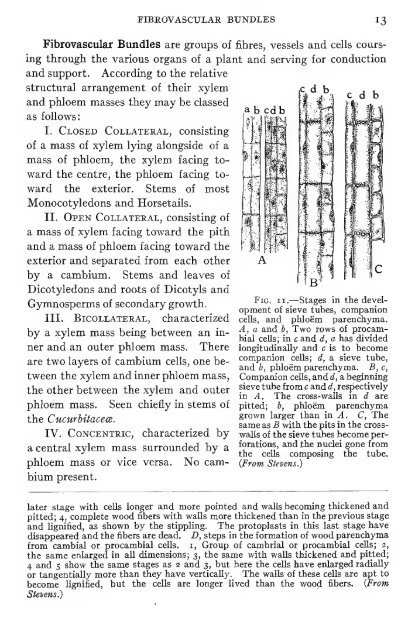Pharmaceutical botany - Lighthouse Survival Blog
Pharmaceutical botany - Lighthouse Survival Blog
Pharmaceutical botany - Lighthouse Survival Blog
Create successful ePaper yourself
Turn your PDF publications into a flip-book with our unique Google optimized e-Paper software.
ITBEOVASCULAR BUNDLES 13<br />
Fibrovascular Bundles are groups of fibres, vessels and cells cours-<br />
ing through the various organs of a plant and serving for conduction<br />
and support. According to the relative<br />
structural arrangement of their xylem<br />
and phloem masses they may be classed<br />
as follows:<br />
I. Closed Collateral, consisting<br />
of a mass of xylem lying alongside of a<br />
mass of phloem, the xylem facing toward<br />
the centre, the phloem facing toward<br />
the exterior. Stems of most<br />
Monocotyledons and Horsetails.<br />
II. Open Collateral, consisting of<br />
a mass of xylem facing toward the pith<br />
and a mass of phloem facing toward the<br />
exterior and separated from each other<br />
by a cambium. Stems and leaves of<br />
Dicotyledons and roots of Dicotyls and<br />
Gymnosperms of secondary growth.<br />
III. BicoLLATERAL, characterized<br />
by a xylem mass being between an in-<br />
ner and an outer phloem mass. There<br />
are two layers of cambium cells, one be-<br />
tween the xylem and inner phloem mass,<br />
the other between the xylem and outer<br />
phloem mass. Seen chiefly in stems of<br />
the Cucurbitacecs.<br />
IV. Concentric, characterized by<br />
a central xylem mass surrounded by a<br />
phloem mass or vice versa. No cambium<br />
present.<br />
C d<br />
I<br />
.1 11<br />
i3|<br />
1^<br />
i-iw»te-j<br />
B<br />
i *"?'<br />
Fig. II.- -Stages in the development<br />
of sieve tubes, companion<br />
cells, and phloem parenchyma.<br />
A, a and 6, Two rows of procambial<br />
ceUs; in and d, a has divided<br />
longitudinally and c is to become<br />
companion cells; d, a sieve tube,<br />
and b, phloem parenchyma. B, c,<br />
Companion cells, and d, a beginning<br />
sieve tube from c and d, respectively<br />
in A. The cross-walls in d are<br />
pitted; b, phloem parenchyma<br />
grown larger than m A. C, The<br />
same as B with the pits in the crosswalls<br />
of the sieve tubes become perforations,<br />
and the nuclei gone from<br />
the cells composing the tube.<br />
(From Stevens.)<br />
later stage with cells longer and more pointed and walls becoming thickened and<br />
pitted; 4, complete wood fibers with walls more thickened than in the previous stage<br />
and lignified, as shown by the stippling. The protoplasts in this last stage have<br />
disappeared and the fibers are dead. D, steps in the formation of wood parenchyma<br />
from cambial or procambial cells, i, Group of cambrial or procambial cells; 2,<br />
the same enlarged in all dimensions; 3, the same with walls thickened and pitted;<br />
4 and 5 show the same stages as 2 and 3, but here the cells have enlarged radially<br />
or tangentially more than they have vertically. The walls of these cells are apt to<br />
become lignified, but the cells are longer lived than the wood fibers. {From<br />
Stevens.)
















